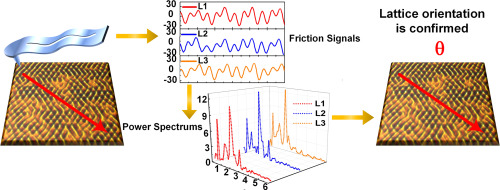当前位置:
X-MOL 学术
›
Mater. Des.
›
论文详情
Our official English website, www.x-mol.net, welcomes your
feedback! (Note: you will need to create a separate account there.)
A novel and facile method for detecting the lattice orientation of MoS2 tribological surface using the SPSA process
Materials & Design ( IF 7.6 ) Pub Date : 2017-12-01 , DOI: 10.1016/j.matdes.2017.08.067 Meng Li , Yu Zhang , Peng Yu , Ning Xi , Yuechao Wang , Lianqing Liu
Materials & Design ( IF 7.6 ) Pub Date : 2017-12-01 , DOI: 10.1016/j.matdes.2017.08.067 Meng Li , Yu Zhang , Peng Yu , Ning Xi , Yuechao Wang , Lianqing Liu

|
Abstract Lattice orientation detection techniques are crucial for two-dimensional materials as many unusual properties, such as electronic, optical, catalytic and magnetic properties, are closely related to particular lattice orientations. Herein, we propose a novel, low-cost and convenient detection technique, referred to as a single-line-scan power spectrum analysis (SPSA), which is established based on the power spectrum analysis of friction information that is extracted from an atomic-resolution lateral friction microscopy image. By analysing the characteristics of the friction information and the corresponding frequency spectrum obtained from the tribological surface of MoS2, we innovatively establish a relationship between the frequency characteristics and lattice orientation and ultimately propose our SPSA, which enables detection of the direct lattice orientation using the frequency characteristic values of an arbitrary line on an atomic image. The experimental results further verify the effectiveness and convenience of the SPSA process.
中文翻译:

一种使用 SPSA 工艺检测 MoS2 摩擦表面晶格取向的新型简便方法
摘要 晶格取向检测技术对于二维材料至关重要,因为许多不寻常的性质,如电子、光学、催化和磁性等,都与特定的晶格取向密切相关。在此,我们提出了一种新颖、低成本且方便的检测技术,称为单线扫描功率谱分析(SPSA),它是基于从原子中提取的摩擦信息的功率谱分析而建立的。分辨率横向摩擦显微镜图像。通过分析从 MoS2 摩擦表面获得的摩擦信息特征和相应的频谱,我们创新地建立了频率特征和晶格取向之间的关系,并最终提出了我们的 SPSA,它可以使用原子图像上任意线的频率特征值检测直接晶格取向。实验结果进一步验证了SPSA工艺的有效性和便利性。
更新日期:2017-12-01
中文翻译:

一种使用 SPSA 工艺检测 MoS2 摩擦表面晶格取向的新型简便方法
摘要 晶格取向检测技术对于二维材料至关重要,因为许多不寻常的性质,如电子、光学、催化和磁性等,都与特定的晶格取向密切相关。在此,我们提出了一种新颖、低成本且方便的检测技术,称为单线扫描功率谱分析(SPSA),它是基于从原子中提取的摩擦信息的功率谱分析而建立的。分辨率横向摩擦显微镜图像。通过分析从 MoS2 摩擦表面获得的摩擦信息特征和相应的频谱,我们创新地建立了频率特征和晶格取向之间的关系,并最终提出了我们的 SPSA,它可以使用原子图像上任意线的频率特征值检测直接晶格取向。实验结果进一步验证了SPSA工艺的有效性和便利性。











































 京公网安备 11010802027423号
京公网安备 11010802027423号